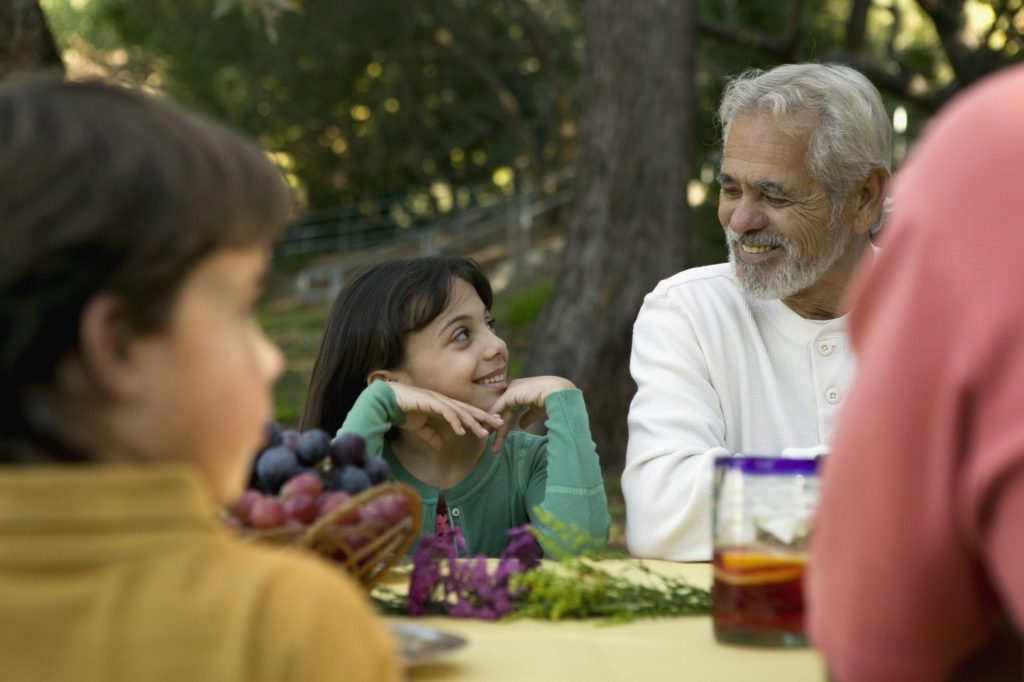Listen to this Chapter
Street Resilience Boosters
Booster 1: Get Out of your Comfort Zone

Have you noticed that today’s society seems to be more divided than ever? We consume whatever news media seems to best fit our own worldview, and tend to assume that everyone else is wrong. When we log on to social media sites like Facebook, we see more information that reinforces the way we see the world, because the Facebook algorithm works really hard to only put stuff in front of you that it thinks you’re going to like. This means that we have very little exposure to anything that challenges our opinions or mindsets. This is certainly a comfortable way to live, but it’s not what society needs. If we all go outside our comfort zone and try our best to understand “the other side,” we’ll be less polarized, more peaceful, and make more progress.
If we all go outside our comfort zone and try our best to understand “the other side,” we’ll be less polarized, more peaceful, and make more progress.
How Families Can “Get the Whole Picture”
So how do we as parents improve our ability to “get the whole picture,” and how do we transfer that skill onto our children? For starters, you could:
Head to the local library with your kids more often. Check out books that challenge your way of thinking. Read books with your children about other countries and cultures. Many children’s books can help your kids better understand their own culture and identity, and can increase their understanding of other groups of people.
Talk about what’s happening in the news with your children. Find out what they know about a certain news story and what their opinion is on it. Then, whether you agree or not, point out some alternate ways that other people might be thinking about that event.
Attend the worship service of a faith different from your own. Get to know the people there. Feel free to ask questions, but remember to be respectful. Afterward, talk to your kids about what they liked about the experience.

Learn words in another language. It can be fun for kids to learn terms like “I love you,” “Thank you,” and “You’re welcome” in a foreign language. Start by learning these terms in languages that might be spoken in your child’s classroom.
Expose your children to foods from other cultures. Go to a restaurant and try a new dish, or find a recipe online and make it together.
Celebrate the holiday of a different cultural group. Learn the customs, traditions, and activities associated with that holiday by talking to others or reading online. You might even have your children invite their friends over to join you.
Make friends from other cultures and groups. This is, by far, the best way for you and your children to “get the whole picture” and learn how to celebrate differences. Encourage your children’s friendships with children from other religions, ethnicities, and abilities.
Don’t criticize entire groups. Be careful with the words you use around your children. If you’ve been wronged or upset by someone from another culture, religion, or ethnic group, remember that it doesn’t mean everyone from that group is that way. Teach your kids the difference between being upset at an individual and discriminating against an entire group, and do your best to find the positive characteristics of everyone you interact with.
Getting a Whole Picture View of Family Members

Getting the whole picture is equally important with your children and partner. When we commit to gaining a complete understanding of our children’s experiences and mindsets, we open the door to a new frame of mind and become increasingly resilient. Ask yourself, “If I more fully understood the fears, anxieties, moods, setbacks, opinions, and challenges of each family member, would I be more or less likely to be respectful of them and their value?” Can you think of a group of people more deserving of your respect than your own family members? What if we could literally get inside the minds and hearts of our loved ones? What might we learn? How might those insights make us (and your partner or child) more resilient? Consider these ideas as you attempt to get a whole picture view within your own family:
Try to use open-ended questions and statements, rather than closed-ended ones (those that elicit a one-word answer). For example, “Tell me about your day” is more likely to generate a conversation than “How was your day,” which will likely get a response like “Fine” or “OK.”
Keep in mind that getting the whole picture is a bit like peeling an onion – you do it one layer at a time. If there hasn’t been a lot of back and forth communication between you and your family members, don’t expect to learn everything on your first attempt.
Be willing to be vulnerable. Share something that shows you’re a member of the human race by revealing a fear, anxiety, or mistake you’ve made. This can “prime the pump” and create a more open atmosphere.
Be very cautious about giving advice, especially if a relationship isn’t strong. Even though you’re convinced you could solve the other’s problem, take a tentative position. Ask if he or she would be interested in your opinion. If you sense hesitancy, hold off rushing in with the “answer” and work on building trust through sincere efforts to simply understand, rather than attempting to be understood.
Discussing this Booster with Your Child
Explain to your children that getting the whole picture means that you are willing to look at things (and people) from a more open-minded perspective. Discuss what it means to be open-minded. Have your children think of ideas of ways that they could become more open-minded.
Complete one of the activities listed above under “How families can get the whole picture” with your children. Have them help you plan the activity, and talk about it afterward. What did they learn? Would they do it again?

Reflection
Taking notice of the needs and positive traits of the people around you and acting accordingly – Expressing gratitude and helping others when you see a need. Take a moment to be completely honest with yourself about your biases – whether they’re political, religious, or towards another group of people. Spend a day taking a different perspective on one of your biases, genuinely attempting to look at it from a different point of view. Listen to news outlets or watch other media that challenge your bias. What did you learn? Did this exercise help you come closer to getting a “whole picture” view? Taking notice of the needs and positive traits of the people around you and acting accordingly – Expressing gratitude and helping others when you see a need.
“It’s important to note that exposure alone does not necessarily equal enlightenment and make you more resilient. Rather, exposure while seeking to get the whole picture view is what leads to insight and expanded perception.”
The Resilience Breakthrough, page 120
Booster 2: Focus on the Positive
Start with You

We don’t need to remind you of your mistakes – you probably do a decent job of that on a daily basis all on your own. It’s human nature to focus on all the things that are wrong with you, and it seems to only get worse when you become a parent – suddenly all your flaws are facing you like a mirror in the things your kids do and say, and you constantly find yourself asking that big, scary question: “What if I’m doing it wrong?”
Reevaluating specific parenting choices isn’t a bad thing, but let’s replace the big, scary question with one that’s much nicer – one that you should be asking yourself on a nightly basis: “What did I do right today? How can I do more of that tomorrow?”
It may take time and practice to learn to acknowledge the things that are good and right about you. You may want to make a list of the things you’re doing right, just so you can remind yourself when you’re having doubts. Consider getting opinions from third-party observers like a partner, close friend, or other family members on the positive qualities you possess as a parent. Make sure to avoid the toxic trap of comparing yourselves to others in the process.
Then Focus on Your Family
When you’re in the habit of focusing on what you’re doing right in your own life, it becomes easier to identify the positive qualities of those around you, like your partner and children. It’s easy to fall into the mindset of catching our family members doing what’s wrong, failing to consider the harm done. Make no mistake – a certain amount of discipline and order are essential in any family situation. However, a family-focused solely on getting things done or what is missing can lose the feelings of safety, harmony, and love that every home should have.
We ought to be paying attention to what spouses, partners, and children are doing right, and then making certain they know that we notice their efforts.
But how to start? What about trying to apply the 5:1 ratio, that is, for every corrective or critical comment you make, come up with five positives to say to your family member. Here are some other suggestions:

Ask, “What went well for you today?” when a family member arrives home from school or work. Maybe the person has a hard time thinking of something positive about their day, so you can point out things you may have noticed, such as getting up on time or helping with morning dishes.
Become more mindful of the lives of family members. Put down your electronic device (see the booster on page 61) and pay attention to the little things that might otherwise go unnoticed, like a child making sure the family pet is fed and watered without being asked and then commenting on what you just saw.
Try to catch people in your family doing something right, positive, or good, and tell them what you noticed.
When a correction is necessary, avoid creating defensiveness or arguments by simply stating what you observed and what you expected rather than using negative labels or blaming. For instance, if a child has been assigned to help with dinner cleanup and you see him heading out the door to meet a friend, say something like, “Kevin, I notice you’re leaving, but we agreed you’d help do the dishes and clean the table after dinner. Can you take care of that before you do other things?”
As you focus on what’s right with yourself and with your children, a more positive atmosphere will fill your home, helping you feel confident in your parenting abilities and helping your children recognize and take ownership of their own positive qualities.
Discussing this Booster with your Family
Ask your children to think of at least one thing they did right today. This may be difficult for some children, so be ready to point out any positive actions you saw your child take that day.
Ask your children what they think would happen if every day they asked themselves, “What did I do right today?” then tried to do more of that thing the following day.
Reflection
Write a letter to your child focusing on some of his/her positive attributes. Be specific. Don’t just say, “You are compassionate.” Instead, talk about the behaviors your child did that caused you to conclude that he or she is compassionate, such as, “I noticed last week you went out of your way to help Laura with her Saturday chores, even though this meant you’d have less time to play with your friends.” Better still, try to write about something that happened in the immediate past, like today. How will continued efforts like these contribute to your goal of creating a more resilient family culture?
There will always be people who will focus on what’s wrong with you [and the members of your family], but it’s much more productive to focus on what’s right...”
The Resilience Breakthrough, page 132
Additional Resources
Activities